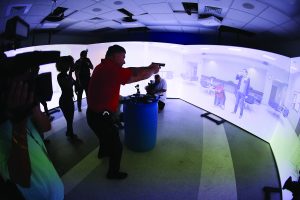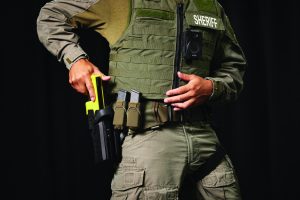At most agencies, there is a specific process for the investigation of police use-of-force incidents. For many agencies, those investigations are initially reported to the field supervisor, then the report makes its way through the chain of command, usually resulting in someone at the command or executive level rendering a disposition on the result of investigation. While command oversight is important in potentially high-liability incidents, as some will inevitably end up in civil litigation, by using this process alone, agencies miss a valuable opportunity to address larger organizational issues. Concern for police liability should not be discounted; however, that risk can be significantly minimized when the focus of operations is centered on doing the right things for the right reasons. Contrary to what many may think, modern policing does not operate in the realm of black and white, rather, police work tends to fall into a very gray area where officer discretion and actions may determine whether a situation has a positive or negative outcome.
Many agencies have found themselves with increasingly younger and less-experienced police forces that result in less-experienced officers training their new recruits. The constant advancement in tools and techniques coupled with the public expectation that police officers be able to handle everything from crimes to mental health crises to medical situations has led to a large increase in training needs and requirements. In addition, the tools and tactics that require a training threshold necessary to avoid a “deliberate indifference” risk for agency administrators continues to increase. Providing officers with a wide range of tools to use at their discretion, if not properly managed and trained upon, exposes agencies to additional liabilities. A goal for agency administrators should include utilization of policy, tools, tactics, and training that increase the probability of positive and effective force interactions.
In many agencies, especially small and midsize organizations, use-of-force investigations are a collateral duty relegated to field supervisors. The initial investigation may include preparation of reports; collection of video, audio, and photographs; and initial interviews of involved officers and witnesses. These files are eventually forwarded on to command staff, who will render a judgement as to whether the force used was trained or not trained, justified or not justified. After command staff review, formal disposition is usually handled at the command or executive level. If tracking systems or any number of software packages are utilized, similarities, patterns of behavior, or trends may be detected, and, in a large number of those instances, deficiencies or minor infractions are often considered “training issues.” The extent of follow-up on those issues or any sort of remediation can often be lost in the chain of paperwork or overlooked when the actual trainers are not part of the evaluation process.
The possibility that agencies could fall behind the curve on properly addressing emerging training deficiencies, resulting in increased agency liabilities, should be considered. An examination of previously held training methodology may provide some additional insight into a reexamination of how police agencies train and mitigate risk.
Annual in-service training, meant to cover defensive tactics, certifications, and other relevant topics over a single day or a several-day period, can often result in training to time parameters rather than standards of proficiency. The instructor to student ratio is often 1:10 or higher, with students simply going through the motions on techniques that require skill and competency demonstration. This mass training approach can result in officers not completely understanding the techniques or being able to demonstrate proficiency, leading to misapplication and officer deficiencies that go undetected until a use-of-force investigation is required.
An additional concern is the belief that product manufacturers’ standards for training on specific tools or weapons is an absolute. While manufacturer recommendations should be incorporated into training, agency policy; law; and most important, demonstrated proficiency should be the driving standards of any training.
 Lastly, a shift in focus on the singular force “event” in a force investigation to include pre- and post-force response and actions can ultimately lead to the discovery of singular or department-wide issues that, if addressed in a timely manner, can prevent repeated issues. Working on the previously stated presumption that many issues discovered in force investigations are truly “training issues,” agencies would find themselves in a much better position to defend their patterns and practices when an all-encompassing investigative method asks the questions, “What led up to the use of force?”; “How was the force applied and was it applied properly?”; and “What actions were taken following the use of force?”
Lastly, a shift in focus on the singular force “event” in a force investigation to include pre- and post-force response and actions can ultimately lead to the discovery of singular or department-wide issues that, if addressed in a timely manner, can prevent repeated issues. Working on the previously stated presumption that many issues discovered in force investigations are truly “training issues,” agencies would find themselves in a much better position to defend their patterns and practices when an all-encompassing investigative method asks the questions, “What led up to the use of force?”; “How was the force applied and was it applied properly?”; and “What actions were taken following the use of force?”
The following proposed concept includes several significant changes from past practices.
Agency Trainer Evaluation
Certified instructors are the subject matter experts (SME) within any agency, particularly those who specialize in high-risk/liability disciplines such as firearms, electronic control weapons (ECW), defensive tactics, oleoresin capsicum (OC or “pepper spray”), collapsible baton and anything requiring annual recertification. Whether an agency utilizes a dedicated cadre of instructors, collateral-duty instructors, or a combination of both, lesson plan continuity and proficiency standards are critical in ensuring techniques are being applied across the department. Ensuring instructors are properly vetted, trained, and certified, whether internal personnel or external providers, helps to ensure the integrity of the training and its conformity to best practices in the industry. Reliance on those in-house subject matter experts as a valuable resource does not, however, relieve agency managers of the responsibility of ensuring training is aligned with current laws, policies, and the agency’s core principles. Executive-level staff within the agency should avoid the trap of sole reliance on product training guidelines, “expert” outside trainers who may be incognizant of some challenges of contemporary policing, or an incomplete understanding of how their officers are actually being trained. The adage of “trust but verify” could easily prevent agency exposure to practices that may develop under the radar.
Focused Training Groups

In this suggested model, traditional, large group in-service training sessions would be replaced by smaller and more focused groups of no more than four officers for defensive tactics training or training of other skills requiring physical application. Allotted time would take into consideration the much smaller group size and the time needed to provide instruction plus time for the students to demonstrate proficiency in the technique or required skill. By taking this approach, the officers will have increased confidence in their ability to perform the techniques—and the agency gains increased confidence in a sound training program should skills or techniques be called into question in litigation. These smaller, focused training sessions can often be handled on duty, as the time required to present material and provide necessary reps is decreased with fewer students. If, in fact, those techniques or force actions are called into question, the officers are in a more solid position to justify their use since proficiency to that standard was their training—and the trainer can articulate such proficiency was demonstrated.
Incorporation of Multiple Disciplines
A training needs assessment has revealed that often times, multiple techniques or tools were used in a single incident. Therefore, it is only logical that multiple training disciplines should also be intertwined to further cognitive and contingency-based decision-making. For example, firearms training in policing has tended to be very linear in nature, and until recently, there was not much emphasis placed on shooting on the move or on communication during shooting incidents. There were also operational training gaps with regard to other disciplines, including defensive tactics and combat wound care. The overhaul in training focuses on marrying other disciplines into training opportunities in order to build in thought processes outside typical linear training for officers. Examples that prove very useful include incorporation of other disciplines such as combat care and tourniquets during firearms training. Another example is small team and defensive tactics application in kinetic impact projectile or ECW training. The incorporation of associated or complementary skills adds an additional level of cognitive training requiring decision-making beyond the singular topic. The belief that the first time an officer is exposed to those situations should not be during an actual event is the basis for cross-over courses.
Trainer Investigation of Use-of-Force Incidents
A key component to this new approach to training is the departure from past use-of-force investigation practices and a shifting in mindset to the actual agency SMEs conducting the force investigation. These cases would be reported through the normal internal notifications system or software system, with that routing beginning with the initial field supervisor and going directly to a singular investigator or supervisor who would either be assigned the investigation or assign it to the appropriate SME for evaluation. A key component to this system is consistency in the routing of incidents to allow for patterns or trends to be discovered and acted upon. The review would no longer focus solely on the force used but would be comprehensive in nature and include all written reports, in-car and body-worn camera video from any officer on the scene, any 911 audio files, and all dispatch audio files of the entire incident. The information would be all-inclusive from the time of the initial call or self-initiated activity through the final disposition/release of the subject from agency custody. By vastly expanding the scope of the investigation, the assigned trainer would be tasked with looking for contributing factors; officer behavior/actions; proper application of actual techniques; and just as important, adequate documentation at all levels. Emphasis should be placed on the involved officers providing detailed and accurate written descriptions of the incident, to include suspect actions and level of resistance along with the officers’ directions or response to resistance. Applicable departmental policies on approved tools and techniques along with the application of “objective reasonableness” should be emphasized in all in-house training sessions focusing on the establishment of the Graham standard throughout policy development, training, and application.1
By having this group of SMEs conducting the force review, the agency ensures that those responsible for providing training are also responsible for ensuring proper application of force. Future training can thus be guided by identified patterns or widespread deficiencies, and singular, individual problems noted could be addressed with a particular officer as needed.
Once the assigned investigator compiles the use-of-force case file, a disposition of either “Trained and Justified,” “Not Trained and Justified,” “Trained but Not Justified,” or “Not Trained and Not Justified” should be rendered before forwarding on for command staff review. The use-for-force investigator is not responsible for handling any further internal affairs investigation or discipline that may come about as a result of the review and is only providing facts to command staff for disposition.
Outcomes
Positive results from this shift in practice were seen almost immediately in the agencies utilizing this methodology. Because the training sessions were determined based on demonstrated proficiency, rather than arbitrary time parameters, sessions were often shorter in duration and could be accomplished on duty. Additional positive results were noted:
Proficiency in the application of techniques was noted by the instructors and received very positive feedback from the officers.

Timely and positive control of subjects through the utilization of approved physical control techniques began to increase while the reliance on ECWs decreased, resulting in fewer injuries to suspects and officers. ECWs remained an important tool without it being the “go-to” force option in many cases.
Officer confidence in tools and techniques increased dramatically with a true understanding of the trained topics and tools.
Future training topics were developed from the evaluation of issues and deficiencies revealed as patterns or trends.
A singular approach may not be applicable to every agency size; however, implementation of such foundational principles in a training approach to force investigations and risk mitigation is possible with a sound evaluation of current internal agency practices. By shifting focus to proficiency-based training, policy, and practices rooted in the Graham standard of objective reasonableness, and utilization of in-house SMEs in all or part of the use-of-force investigation process, agencies will likely find the end result to be more confident officers making sound and defendable decisions with properly applied force options. In other words, the agency will achieve the desired results with decreased liability borne from the establishment of sound practices. 🛡
 Chief Fred Farris is currently the chief of police for the Gladstone, Missouri, Police Department. He began his law enforcement career with the Kansas City, Missouri, Police Department in 1990. From 1995–2017, he served with the Lenexa, Kansas, Police Department, including 20 years as an operator and team leader with the Tactical Unit. In 2017, he was appointed as the chief of police for the Goddard, Kansas, Police Department. He served as the Training Committee chair for the Kansas Association of Chiefs of Police and is a member and cochair of the IACP Patrol and Tactical Operations Committee. He has served as a board member, member, and subject matter expert for numerous tactical and police associations. Chief Fred Farris is currently the chief of police for the Gladstone, Missouri, Police Department. He began his law enforcement career with the Kansas City, Missouri, Police Department in 1990. From 1995–2017, he served with the Lenexa, Kansas, Police Department, including 20 years as an operator and team leader with the Tactical Unit. In 2017, he was appointed as the chief of police for the Goddard, Kansas, Police Department. He served as the Training Committee chair for the Kansas Association of Chiefs of Police and is a member and cochair of the IACP Patrol and Tactical Operations Committee. He has served as a board member, member, and subject matter expert for numerous tactical and police associations. |
Note:
1Graham v. Connor, 490 U.S. 386 (1989).
Please cite as
Fred Farris, “A Training Approach to Use-of-Force Investigations,” Police Chief Online, June 19, 2024.


